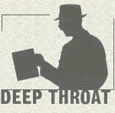|
Answer:
Deep Throat, the ghostly
character who has haunted the journalistic imagination
for over a generation, is Harold Rowe Holbrook Jr. In
the film version of the Watergate expose All The President's
Men, Holbrook is depicted as a pale white flickering
figure in a surrealistic underground garage meeting
the fledgling reporter Bob Woodward (played by Robert
Redford). And, in these eerie late night meetings, he
provides Woodward with the White House secrets that
Woodward, together with his writing partner Carl Bernstein
(played by Dustin Hoffman), uses to unseat the Nixon
Government. Deep Throat was in a position to furnish
these secrets, according to Woodward, because his "sensitive"
position in the executive branch gives him access to
both the secret operations of the Nixon White House
and the inner sanctum of his re-election campaign.
Since Woodward steadfastly
refused to provide any clues to the identity of the
man in the underground garage to anyone, including the
film's screenplay writer, William Goldman, Holbrook
had to invent the attributes he bestowed on his shadowy
character. The dialogue Goldman wrote for Holbrook is
mainly based on Deep Throat's verbatim quotes in the
book version of All The President's Men, but since Woodward
agreed (p.71) "never to quote the man, even as
an anonymous source," the quotes he attributes
to him in the book presumably must be fictive. And Goldman
has added his own fictitious lines, such as the celebrated
"follow the money," which does not even appear in the
book. So Holbrook's ashen underground man is fictional.
But is the anonymous character on whom its based a real
person or is he, like so many fictional products, an
amalgam of many people?
Deep Throat does not appear
in Woodward and Bernstein~s news stories in the Washington
Post. These stories have other multiple sources for
the disclosures attributed to a single source-- Deep
Throat-- in the book All The President's Men. For example,
the disclosure said at least "50 people" who
worked for the White House and Nixon campaign were involved
in spying and sabotage is attributed to "FBI reports"
in the Washington Post (October 10, 1972, p A1), but
in the book (p.134) it is attributed exclusively to
Deep Throat. Similarly, the so-called "canuck letter"
is attributed to "law enforcement sources"
in the Washington Post (October 10, 1972, p A1) but
in the book to Deep Throat(P.134). So there is alternative
sourcing in the newspaper and book.
As it turns out, Deep
Throat also was not included in the proposal Woodward
and Bernstein submitted to their book publisher Simon
& Schuster. And, according to David Obst, their literary
agent, Deep Throat was not in the book they initially
submitted. Obst noted: "In the original draft of their
book, Deep Throat was not mentioned. In the second draft
he suddenly appeared - and it was a better book for
the addition, a much more exciting one.'' If so, this
'addition,' the inserted Deep Throat, became the sole
provider of secrets that had been previously sourced
to multiple sources and FBI documents.
Deep Throat's late appearance
does provide the sort of intrigue that journalistic
myths are made of. It also created a few internal contradiction.
For example, the inserted Deep Throat is so concerned
about surveillance that he sneaks messages into Woodward's
home-delivered newspapers arranging the underground
rendezvous. Then, he takes Woodward to a public bar
for a drink, explaining they were unlikely to run into
anyone they knew there forgetting about the surveillance?)
Contradictions of course happen both in real and imaginary
life.
Fortunately, the the fact-or-fiction
issue is definitively settled by Woodward himself. On
page 71 of All The President's Men (final version ,
he writes that Deep Throat's "identity was unknown
to anyone else." How is it possible for Woodward
to know that no one but him knows his identity. If Deep
Throat was a real person, and acted liked other sources,
he conceivably could have contacted other reporters,
or even friends, and told them much the same information
that Woodward describes such detail. He might even have
met them in the same underground garage at different
hours and slipped messages into their home delivered
newspapers. The only way that Woodward can state with
such certainty that he, and he alone, knows the identity
of this character is that he is his exclusive creation.
The wrong question, to ask then is :Who Is Deep Throat?
|


